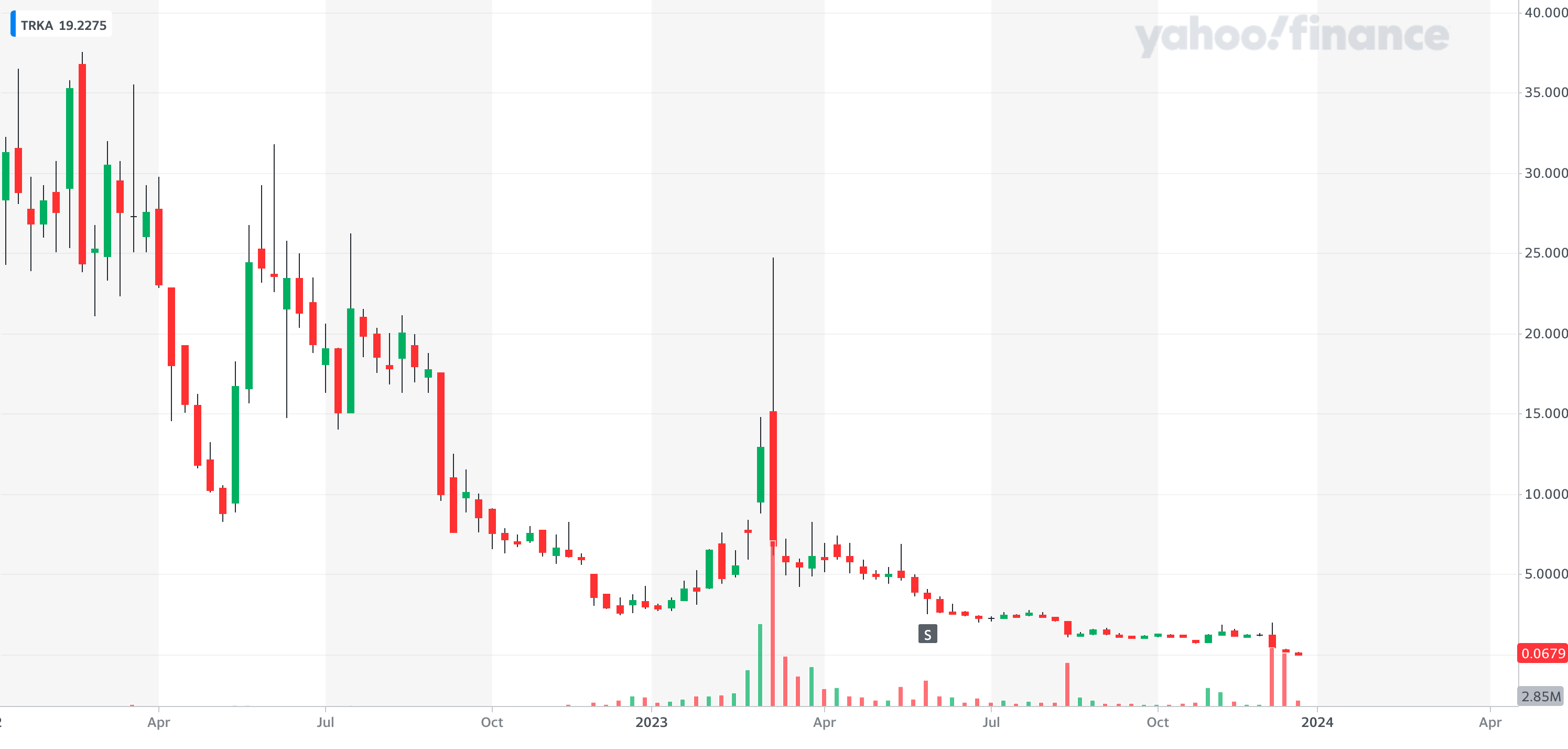Introduction: The Rise and Challenges of Troika Media Group, Inc.
Troika Media Group, Inc. (TRKA): A Media Powerhouse in Transition
Troika Media Group, Inc., commonly referred to as TRKA, has been a notable name in the media and entertainment industry. Specializing in a wide range of services that encompass branding, marketing, and creative production, TRKA has made significant strides in connecting brands with their audiences through innovative and engaging solutions. Known for its expertise in creating compelling narratives, the company has been instrumental in shaping brand identities and crafting unique media experiences.
Diverse Portfolio in Media and Entertainment
At its core, TRika Media Group’s business revolves around three primary sectors: digital marketing, brand consultancy, and technology services. These sectors converge to provide a comprehensive suite of services that include everything from digital advertising campaigns to immersive brand experiences. The company’s proficiency in leveraging the latest technologies and creative strategies has enabled it to stand out in a competitive market, servicing a diverse clientele ranging from startups to established multinational corporations.
Navigating Market Turbulence: The Nasdaq Delisting
However, the company’s journey has not been without its challenges. In a significant recent development, TRKA was delisted from the Nasdaq stock exchange. This move came as a result of several factors, including fluctuations in stock performance and broader market conditions. The delisting of TRKA marks a pivotal moment in the company’s history, raising questions about its future trajectory and the implications for investors and stakeholders. The delisting process, which can often be complex and multifaceted, signals a period of transition for Troika Media Group as it navigates this new chapter in its corporate journey.
Troika Media Group: Adapting to a Changing Landscape
The delisting from Nasdaq is a critical moment for Troika Media Group, Inc., signifying both the challenges and opportunities that lie ahead. As the company reevaluates its strategies and approaches in this evolving landscape, it remains to be seen how it will leverage its core strengths to overcome these hurdles and continue to innovate in the dynamic world of media and entertainment.
Analyzing the Rollercoaster Ride of TRKA’s Stock Performance
A Year of Unprecedented Fluctuations for Troika Media Group
Over the past year, Troika Media Group, Inc. (TRKA) has experienced a dramatic rollercoaster ride in its stock performance. Once a steady player in the media and entertainment sector, the stock has seen a tumultuous period, characterized by sharp declines and unpredictable volatility. This section delves into the details of these fluctuations, offering insights into the significant shifts in TRKA’s stock value.
The Steep Decline: A 94.98% Drop in Stock Value

One of the most striking aspects of TRKA’s stock performance has been the substantial decrease in its value – a staggering 94.98% drop over the past year. This decline is not just a number; it reflects deeper issues within the company and potentially, within the industry at large. This severe drop in stock price raises questions about the underlying factors driving this decline, including market confidence, operational challenges, and broader economic conditions affecting the media sector.
Navigating Through High Volatility: Understanding TRKA’s Beta Value
In the world of stock trading, the beta value is a crucial indicator of volatility. TRKA’s beta value stands at 2.10, significantly higher than the market average. This high beta value signifies that the stock is more volatile compared to the broader market. For investors, this means that TRKA’s stock has been subject to larger swings in price, both upwards and downwards, than a typical stock. This level of volatility is a double-edged sword; it presents opportunities for high returns but also comes with increased risk.
The Implications of Volatility for Investors and the Company
The high volatility of TRKA’s stock has implications for both investors and the company itself. For investors, particularly those with a short-term focus, the high beta value suggests the potential for rapid gains, but with the risk of equally swift losses. For the company, such volatility can affect everything from investor confidence to the ability to raise capital. It also puts additional pressure on the company’s management to stabilize and improve financial performance.
Corporate Actions and Market Response: Navigating Troika Media Group’s Strategic Decisions
The Strategic Move: 1-for-25 Reverse Stock Split
In a significant corporate action, Troika Media Group, Inc. (TRKA) announced a 1-for-25 reverse stock split. This strategic decision meant that for every 25 shares owned by shareholders, they were consolidated into a single share. The primary intent behind such a move is typically to increase the market price of individual shares. By reducing the number of shares in circulation, a company aims to make its stock appear more valuable on a per-share basis, often in an effort to comply with stock exchange listing requirements or to enhance the stock’s appeal to investors.
A Simplified Example
Initial Scenario:
- Imagine you are an investor holding 250 shares of Troika Media Group, Inc. (TRKA).
- Let’s say each share is worth $1, so the total value of your investment is $250.
Implementation of the Reverse Stock Split:
- TRKA announces a 1-for-25 reverse stock split.
- This means that for every 25 shares you hold, they will be consolidated into 1 share.
Post-Split Scenario:
- After the reverse split, your 250 shares are combined into 10 shares (250 divided by 25).
- However, the value of each share is adjusted to reflect this change. Instead of $1, each new share might now be worth $25 (assuming no change in the company’s overall market value).
- So, your 10 new shares are still worth $250 in total (10 shares x $25 per share).
Key Points to Note:
- The total value of your investment remains the same immediately after the split. What changes is the number of shares you hold and the price per share.
- The reverse stock split does not inherently increase the company’s total market value. It’s more of a cosmetic change to the stock’s price and share count.
- The intention behind such a split is often to make the stock price appear higher, which can affect how the stock is perceived by investors and the market.
This example illustrates the basic mechanics of a 1-for-25 reverse stock split. The real-world implications, especially in terms of investor perception and long-term stock performance, can be more complex and varied.
Market Reaction to the Reverse Stock Split
The announcement of the reverse stock split by TRKA was met with mixed reactions in the market. Such corporate actions can sometimes be viewed as a red flag by investors, indicating potential underlying issues with the company’s financial health or stock performance. However, it can also be perceived as a proactive strategy to reposition the company in the market. The immediate aftermath of TRKA’s announcement saw fluctuations in stock prices, reflecting investor uncertainty and the market’s attempt to reassess the value and future prospects of the company.
Impact on Investor Confidence and Stock Performance
The decision to undertake a reverse stock split has significant implications for investor confidence and stock performance. For TRKA, this move was critical in shaping investor perceptions. On one hand, it signaled a commitment to maintaining listing standards and improving stock marketability. On the other hand, it raised questions about the company’s long-term financial stability and growth prospects. The impact of such corporate actions on stock performance is complex, often influenced by broader market conditions, the company’s communication around the decision, and subsequent financial performance.
Looking Ahead: Assessing the Long-term Effects
While the immediate market response to TRKA’s reverse stock split provided some insights, the long-term effects of this action on the company’s stock performance and investor confidence will be more telling. It remains to be seen how effectively TRKA can leverage this corporate action to stabilize and potentially enhance its market standing.
Financial Health and Market Position
Troika Media Group’s Financial Performance
Troika Media Group Inc. reported revenues of $54.2 million and $172.0 million for the three and nine months ended September 30, 2023, respectively. However, these figures represent a significant decline from the previous year, with a 55% decrease in quarterly revenue and a 22% decrease over nine months. This decline was primarily due to reduced revenues from managed services and performance solutions, particularly in the legal and home services sectors.
Gross Profit and Operational Costs
The company’s gross profit for the same periods also saw a downturn, dropping by 53% and 42%, respectively. This decrease in gross profit was attributed to increased competition in lead acquisition and reduced marketing spend by insurance and telecom clients. Troika’s gross profit challenges were further compounded by the high costs associated with performance solutions, which often require significant upfront investments with uncertain revenue outcomes.
Selling, General, and Administrative Expenses
Troika managed to reduce its selling, general, and administrative expenses, primarily due to decreased personnel, facilities, and occupancy costs. However, these reductions were offset by increased professional fees and costs associated with public company operations. The company also incurred significant non-recurring expenses related to efforts in reducing debt service and stabilizing its capital structure.
Chapter 11 Bankruptcy Filing
Adding to the financial woes, Troika Media Group filed for relief under chapter 11 of the United States Bankruptcy Code in December 2023. This filing indicates a strategic move to reorganize and address financial challenges, but it also reflects the significant difficulties the company has been facing.
Adjusted EBITDA and Net Income
The adjusted EBITDA for the three and nine-month periods ended September 30, 2023, showed substantial decreases from the previous year, primarily due to the decline in gross profit. The company’s operating and net income also suffered significant losses, driven by impairment losses on intangible assets and goodwill.
Assessing Troika Media Group’s Prospects
1-Year Target Estimate and Company’s Future
- The 1-year target estimate of $37.50 for Troika Media Group Inc (TRKA) seems ambitious, especially considering the company’s current trading price hovering around $0.34, which is a drastic 98.64% decline from its 52-week high of $24.75.
- This target estimate implies a significant turnaround and recovery in the company’s stock value. Achieving this would require substantial improvements in financial performance and operational efficiency.
Industry Trends and Impact on TRKA
- TRKA, operating in the Communication Services sector, has experienced irregular stock market performance and a notable quarterly decline in revenues by 71.28% compared to the previous year.
- The industry trend, particularly in communication services, has been challenging with increased competition and changing consumer preferences. TRKA’s ability to adapt to these trends will be crucial for its recovery.
Debt-to-Equity Ratio and Financial Health
- TRKA’s high debt-to-equity ratio, standing at 5.31, indicates a heavy reliance on debt to finance its assets, which could be a concern for future financial stability.
- Managing this debt effectively and improving the equity position will be vital for the company’s long-term financial health and market reputation.
Potential Recovery Strategies and Future Challenges
- TRKA needs to focus on reducing its debt, improving revenue streams, and enhancing operational efficiency.
- The company may need to explore new markets or diversify its service offerings to adapt to changing industry dynamics.
- Managing investor expectations and regaining market confidence will be critical, especially given the mixed outlook from investors and the significant price loss of -88.41% over the past year.
Conclusion: Troika Media Group’s Tumultuous Journey and the Road Ahead
As we’ve seen, Troika Media Group, Inc. (TRKA) has faced a series of significant financial and operational challenges. From a dramatic decline in stock value to complex restructuring efforts, the company’s journey exemplifies the volatile nature of the communication services industry. Key takeaways from TRKA’s recent experiences include the importance of financial stability, the impact of market trends on company performance, and the critical role of strategic decision-making in navigating corporate challenges.
For readers interested in delving deeper into the intricate world of corporate finance and market trends, our blog offers a wealth of information and insights. We invite you to explore our other articles for more detailed analyses and discussions on similar topics.
Lastly, if you found this article informative and thought-provoking, we encourage you to share it with your network. Your engagement helps us to continue providing high-quality content and contributes to a broader understanding of the dynamic and ever-evolving corporate landscape.



